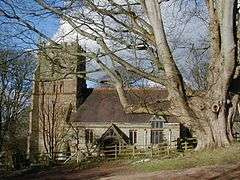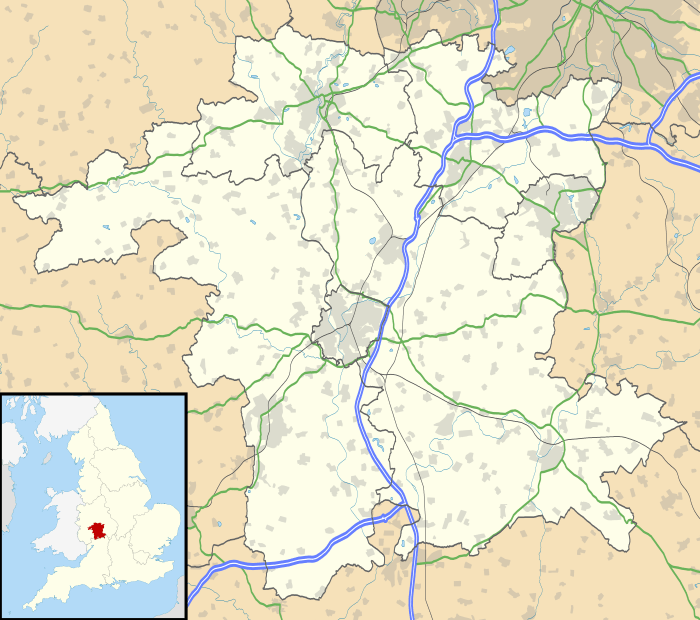Beoley
| Beoley | |
 St Leonard's parish church |
|
 Beoley |
|
| Population | 945 (parish, including Holt End) (2001 census)[1] |
|---|---|
| OS grid reference | SP0669 |
| – London | 95 miles (153 km) |
| Civil parish | Beoley |
| District | Bromsgrove |
| Shire county | Worcestershire |
| Region | West Midlands |
| Country | England |
| Sovereign state | United Kingdom |
| Post town | Redditch |
| Postcode district | B98 |
| Dialling code | 01527 |
| Police | West Mercia |
| Fire | Hereford and Worcester |
| Ambulance | West Midlands |
| EU Parliament | West Midlands |
| UK Parliament | Bromsgrove |
|
|
Coordinates: 52°19′26″N 1°54′22″W / 52.324°N 1.906°W
Beoley is a small village and much larger civil parish[2][3] just north of Redditch in the Bromsgrove District of Worcestershire, and adjoins Warwickshire to the east. The 2001 census recorded a parish population of 945,[1] most of whom live at Holt End. The parish adjoins Redditch's populous northern suburb of Church Hill,[4] and is also adjacent to the Civil Parishes of Alvechurch, Tanworth-in-Arden, Mappleborough Green and Wythall.[2]
Manor
The estates of the Benedictine Pershore Abbey included lands at Beoleahe from at least the 10th century when Edgar the Peaceful restored them to the monks in AD 972.[5] The Domesday Book of 1086 records that the abbey held 21 hides of land at Beolege and Yardley.[5] The de Beauchamp family of Elmley Castle, ancestors of William de Beauchamp, 9th Earl of Warwick, were mesne lords of the manor from the 12th century until about 1265, when they acquired the overlordship from the abbey.[5] In the 13th century the toponym was variously rendered Boleye, Beleg or Buley.[5] Beoley descended with the de Beauchamps until the death of Henry de Beauchamp, 1st Duke of Warwick in 1446, when it passed to his daughter Elizabeth, wife of George Nevill, 1st Baron Latimer.[5] Beoley remained with the Latimers until John Nevill, 4th Baron Latimer sold it in 1549.[5]
The buyer was William Sheldon, who was succeeded by his son Ralph Sheldon.[5] Ralph was imprisoned in the Marshalsea in 1580 for recusancy but was released on medical grounds.[5] In 1611 his grandson William married Elizabeth, daughter of the recusant William Petre, 2nd Baron Petre.[6] During the English Civil War this William Sheldon was a Royalist, and in 1648 the Parliamentarian authorities sequestrated Beoley.[5] In 1660 after the Restoration of the Monarchy Beoley was restored via Richard Sheldon to William's son, the antiquary Ralph Sheldon.[5] A later Ralph Sheldon inherited Beoley in 1780, but by 1788 it was heavily mortgaged and he sold the manor to a Thomas Holmes.[5] Holmes separated Beoley Hall (see below) and 300 acres (120 ha) of land from the rest of the manor and sold off the two lots to separate buyers.[5]
Beoley Hall
The Sheldons' original manor house at Beoley is said to have been burnt down in 1648, while in the hands of Ralph Sheldon, to prevent it falling into the hands of victorious Parliamentarians.[5] The Sheldons had the present Beoley Hall built after the Restoration of the Monarchy, either late in the 17th[7] or early in the 18th century.[5] It is a neoclassical house on an H-shaped plan, originally entirely three-storeyed, built of brick and entirely stuccoed.[5]
In 1791 Holmes had the east wing rebuilt to plans by John Sanders, with two storeys built to the same height as the original three and a portico with four Tuscan columns.[7] On the south end of the east wing a bow window was added to the ground floor in 1791 and a matching window was subsequently added to the first floor above.[7] The main staircase is lit by a round skylight.[7]
In 1968 Beoley Hall was in poor condition[7] but since 1986 it has been a Grade II listed building.[8] It is now divided into apartments.[9]
Parish church
The oldest parts of the Church of England parish church of Saint Leonard[10] date from the early part of the 12th century[5] and include the chancel arch.[11] The south arcade dates from the early or middle part of the 13th century and the north arcade from about 1300.[11] The west tower is a Perpendicular Gothic[11] addition from about 1400[5] and the north aisle was also rebuilt in the Perpendicular style.[11]
The Sheldon Chapel on the north side was added for the recusant Ralph Sheldon in about 1580.[5] Its stone altar is said to be a gift from Pope Gregory XIII.[5] The church was restored in 1885 and the Sheldon Chapel was restored in 1891.[5]
The tower has a ring of eight bells.[12] The oldest is the tenor bell, cast in 1601 by Hugh Watts[12] of Leicester.[13] The seventh bell was cast in 1611 by one of the Newcombe family of bellfounders of Leicester. The fourth bell was cast in 1622 by Henry III Oldfield[12] of Nottingham.[13] Richard Sanders of Bromsgrove[13] cast the third bell in 1708[12] and the fifth bell in 1709.[12] John Rudhall of Gloucester[13] cast the seventh bell in 1789[12] which completed a ring of six.[5] In 1999 this was increased to eight by the addition of new treble and second bells cast by Whitechapel Bell Foundry.[12]
Amenities
The civil parish of Beoley has two public houses: the Cross and Bowling Green at Branson's Cross, and the Village Inn at Holt End.[14] The village has a first school[15] and a village hall.[16]
Notable people
- Edward Sheldon (1599–1687), translator of religious works from French.
- Ralph Sheldon (1623–1694), Royalist and antiquary, nephew of Edward.
- Mary Whateley (1738–1835), poet and playwright who wrote as Harriett Airy and Mary Darwall (her married name).
- Sarah Cooper (1848–1932), (née Gill), originator of Frank Cooper's Oxford marmalade.
- Sarah Falkland (living), a relief news presenter for BBC Midlands Today.
References
- 1 2 "Area selected: Bromsgrove (Non-Metropolitan District)". Neighbourhood Statistics: Full Dataset View. Office for National Statistics. Retrieved 8 March 2011.
- 1 2 "Beoley". Ordnance Survey. 2013-07-19. Retrieved 2014-02-22.
- ↑ "Bromsgrove District and West Mercia Police Parish Boundaries". Bromsgrove District Council. 2008. Retrieved 2014-02-22.
- ↑ "Extent of Beoley Civil Parish". Ordnance Survey. Retrieved 2014-02-22.
- 1 2 3 4 5 6 7 8 9 10 11 12 13 14 15 16 17 18 19 20 21 Willis-Bund & Page 1924, pp. 12–19
- ↑ E.A.B.Barnard, The Sheldons, 1936, pg. 48
- 1 2 3 4 5 Pevsner 1968, p. 81
- ↑ "Beoley Hall". National Heritage List for England. English Heritage. 16 July 1986. Retrieved 8 March 2011.
- ↑ "Beoley Hall, Beoley". British Listed Buildings. British Listed Buildings. Retrieved 8 March 2011.
- ↑ St Leonard's Church
- 1 2 3 4 Pevsner 1968, p. 80
- 1 2 3 4 5 6 7 Dawson, George; Pickford, Chris; Denton, Philip (3 December 2011). "Beoley S Leonard". Dove's Guide for Church Bell Ringers. Central Council of Church Bell Ringers. Retrieved 6 June 2013.
- 1 2 3 4 Dovemaster (31 October 2012). "Bell Founders". Dove's Guide for Church Bell Ringers. Central Council of Church Bell Ringers. Retrieved 6 June 2013.
- ↑ The Village Inn, Beoley
- ↑ Beoley First School
- ↑ Beoley Village Hall
Sources
- Pevsner, Nikolaus (1968). Worcestershire. The Buildings of England. Harmondsworth: Penguin Books. pp. 80–81.
- Willis-Bund, J.W.; Page, W.H., eds. (1924). A History of the County of Worcester: Volume 4. Victoria County History. London. pp. 12–19.
| Wikimedia Commons has media related to Beoley. |